What is muslin fabric? Muslin is a lightweight cotton fabric that's been popular since ancient times. It originates from the city of Mosul in Iraq.
This versatile textile finds application in everything from photography backdrops to fashion design mock-ups, medical supplies, and home décor items. Its plain weave construction offers exceptional breathability and softness that improve with each wash.
Whether choosing between lightweight or heavyweight varieties, understanding muslin's unique properties will help you make the most of this adaptable fabric.
Key Takeaways
- Muslin fabric is primarily made from cotton. But some varieties may also include silk or viscose.
- Muslin is available in multiple grades and weights, from ultra-lightweight to heavyweight.
- Originally from Mosul, Iraq, muslin reached peak production in the 17th-century Bengal and remains highly valued in global textile markets.
- The fabric excels in various uses, including photography backdrops, clothing patterns, medical bandages, and home décor applications.
What Is Muslin Fabric? Its History and Origins
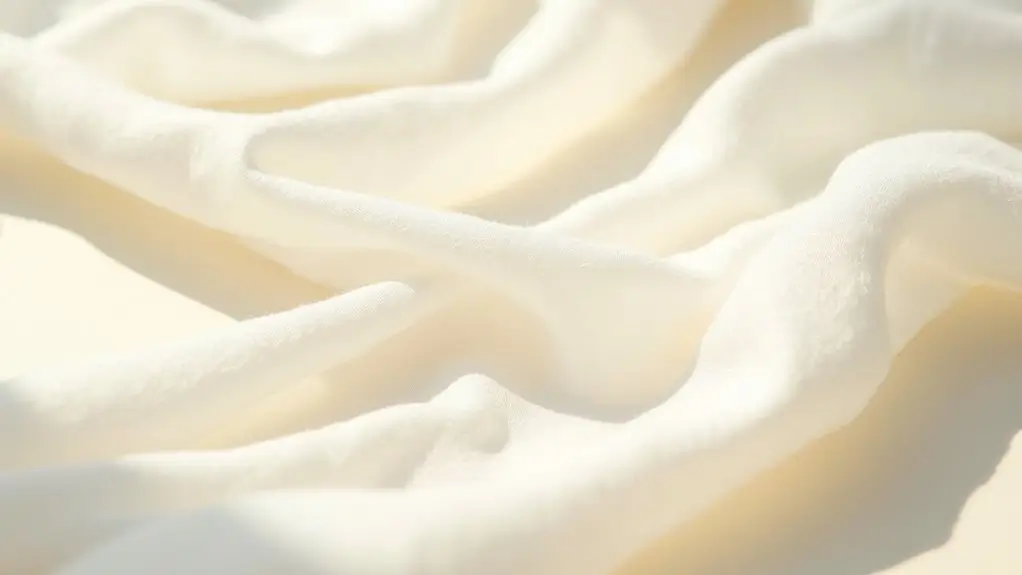
While historians debate muslin's exact origins, the fabric's name traces back to the ancient city of Mosul in present-day Iraq. This lightweight fabric has played a significant role in textile history, particularly in India and Bangladesh.
Muslin production peaked in Bengal during the 17th century, when skilled artisans created wonderful fabric variations. The region's organic cotton and specialized weaving techniques made Bengali muslin highly sought after throughout Europe and Asia.
Today, you can still find traditional types of muslin being made in these regions. But modern manufacturing has made this versatile fabric more widely accessible.
Physical Properties and Characteristics of Muslin
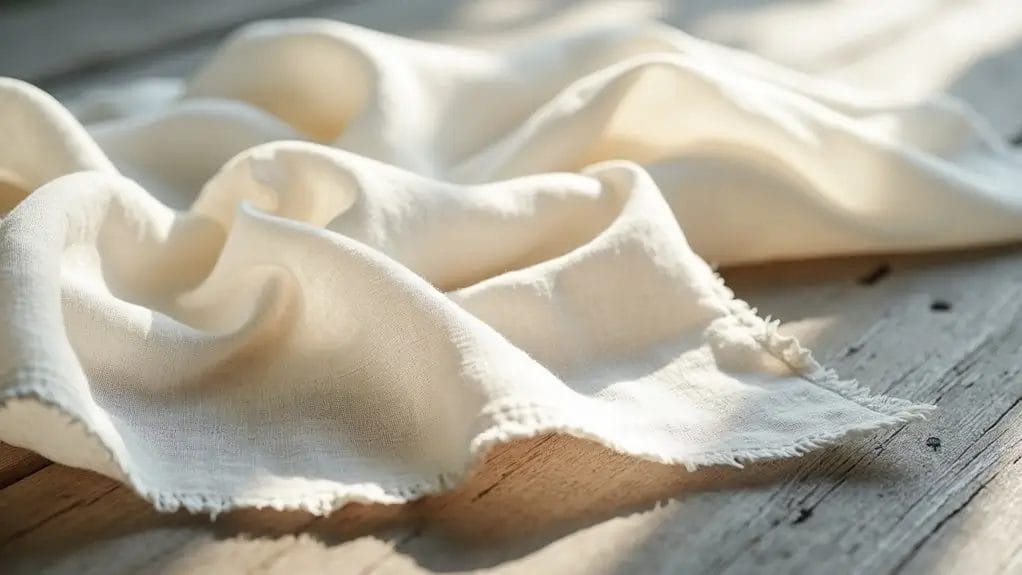
The physical makeup of muslin sets it apart from other cotton fabrics through its distinctive plain weave construction.
This breathable fabric offers exceptional versatility. This is because of its lightweight nature and balanced thread count.
When handling muslin fabric, you'll notice its characteristic softness that increases with each wash.
The fabric's sustainability depends on whether it's organic or conventional cotton. Meanwhile, its durability varies among different types of muslin fabric.
Muslin comes in many varieties, from delicate gauze to sturdy sheeting. Each type maintains the essential properties of breathability and adaptability. These qualities make muslin a timeless choice for both clothing and crafts.
Common Types of Muslin Fabric
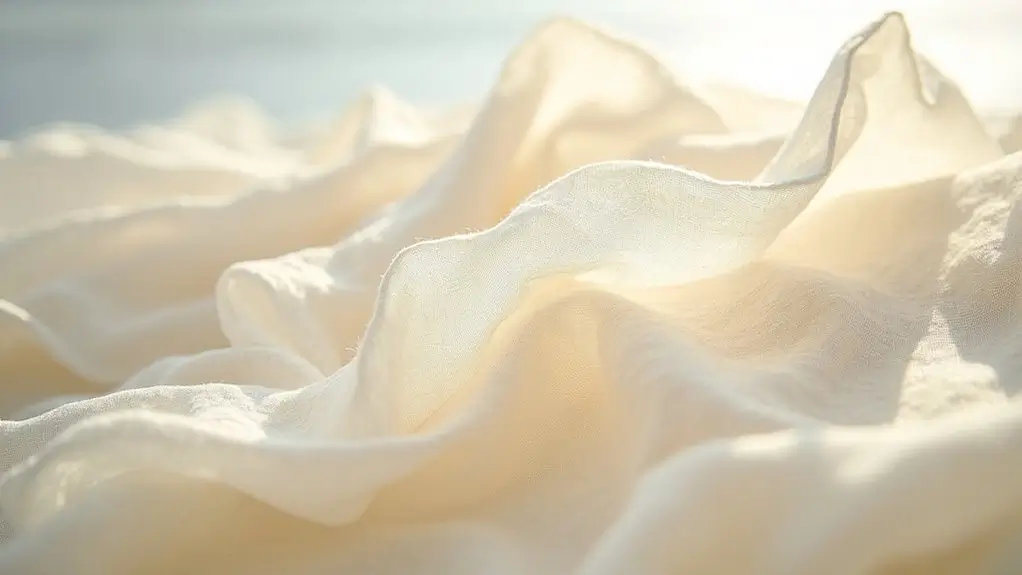
Several distinct types of muslin fabric are available on the market today. They range from organic cotton varieties to specialized grades like "cheesecloth" and "gauze."
Organic Cotton Muslin
Natural and sustainably produced organic cotton muslin represents a premium category within the muslin family. It's crafted without synthetic pesticides or harmful chemicals during the growing process.
When choosing fabric, organic muslin stands out for its environmental benefits and skin-friendly properties. It's particularly popular for baby products, sensitive skin garments, and sustainable fashion designs.
The sustainability of muslin made from organic cotton goes beyond just farming practices. It also includes water conservation and soil preservation methods. These efforts help protect our planet's resources.
Grade Classifications
Several distinct grades of muslin fabric exist in today's market. Each is designed for specific uses and applications. Muslin fabric comes in various qualities, from basic to premium grades.
| Grade Type | Common Uses |
|---|---|
| Grade A | High-end garments, baby wraps |
| Grade B | Pattern making, quilting |
| Grade C | Cleaning cloths, food processing |
Lower grades of this plain-woven fabric work well for temporary uses. Higher grades offer the lightweight fabric quality you'll want for permanent garments and delicate projects.
Lightweight and Heavyweight
Manufacturers primarily categorize muslin into lightweight and heavyweight varieties based on thread count and weave density.
Lightweight muslin is typically used for summer clothing, baby swaddles, and garment mock-ups. This is because of its breathable nature and soft drape.
In contrast, heavy muslin works well for upholstery, curtains, and theatrical backdrops where durability matters most.
The weight you choose should match your project's needs. Delicate items need fine muslin, while structural pieces require heavy muslin.
Textural Variations
Muslin fabric also exhibits distinct textural characteristics that set each variety apart. Each type offers unique properties that make it suitable for specific applications.
- Gauze muslin features an ultra-lightweight, open weave perfect for summer clothing.
- Mull muslin provides a slightly denser texture, ideal for dress underlining.
- Swiss muslin showcases delicate raised patterns with a crisp, refined finish.
- Sheeting muslin offers a sturdy, thick texture suited for home décor.
- Fine muslin delivers a smooth surface like silk that's gentle on sensitive skin.
Popular Uses of Muslin Fabric
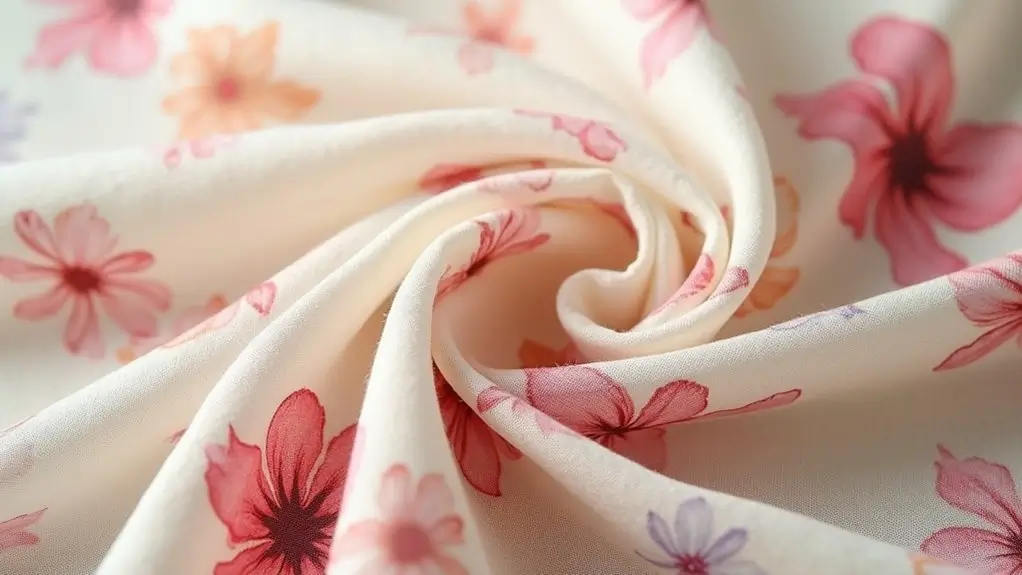
When you're exploring the versatility of muslin fabric, you'll find it's a staple in industries ranging from photography studios to fashion houses.
Photography and Video Backdrops
Muslin is an essential backdrop material in professional photography and video production studios worldwide. This is because of its versatile light-diffusing properties.
This lightweight fabric hangs in studios because it creates smooth, even lighting that photographers love. The plain-weave cotton allows excellent air circulation, preventing heat buildup from studio lights.
- Available in various sizes, from 5x7 feet to massive 20x20 feet backdrops;
- Can be steamed or ironed to remove wrinkles quickly;
- Easily portable and foldable for on-location shoots;
- Comes in multiple colors for different shooting needs;
- More affordable than vinyl or paper alternatives.
Clothing and Fashion Design
Muslin is an indispensable fabric for both everyday clothing and haute couture design. In dressmaking, you can use muslin to create clothing pattern mock-ups before cutting expensive materials.
Muslin's natural breathability makes it perfect for lightweight summer clothing, from flowing dresses to casual shirts.
The fabric's adaptability allows designers to create everything from basic wardrobe essentials to intricate fashion pieces.
Home Decor Applications
Muslin fabric transforms ordinary home décor into cozy, inviting spaces with its natural versatility and soft texture.
This lightweight cotton cloth creates a relaxed, airy atmosphere in any room. Its breathable nature makes it an excellent choice for various home applications.
- Window treatments: Create flowing curtains that filter natural light beautifully.
- Table linens: Craft charming tablecloths and napkins for casual dining.
- Throw pillows: Design custom covers with a soft, natural feel.
- Wall hangings: Display artistic pieces with muslin's neutral backdrop.
- Bed canopies: Fashion dreamy overhead drapes for a romantic touch.
Medical and Surgical Supplies
The sterile, breathable properties of medical-grade muslin make it invaluable in healthcare settings. It's extensively used in hospitals and clinics as an absorbent fabric for bandages, surgical drapes, and wound dressings.
Medical supplies made from muslin cloth are effective. Because they're gentle on sensitive skin while allowing proper air circulation.
The breathable fabric is also used for patient gowns and medical staff's protective clothes.
Manufacturing Process and Production of Muslin Fabric
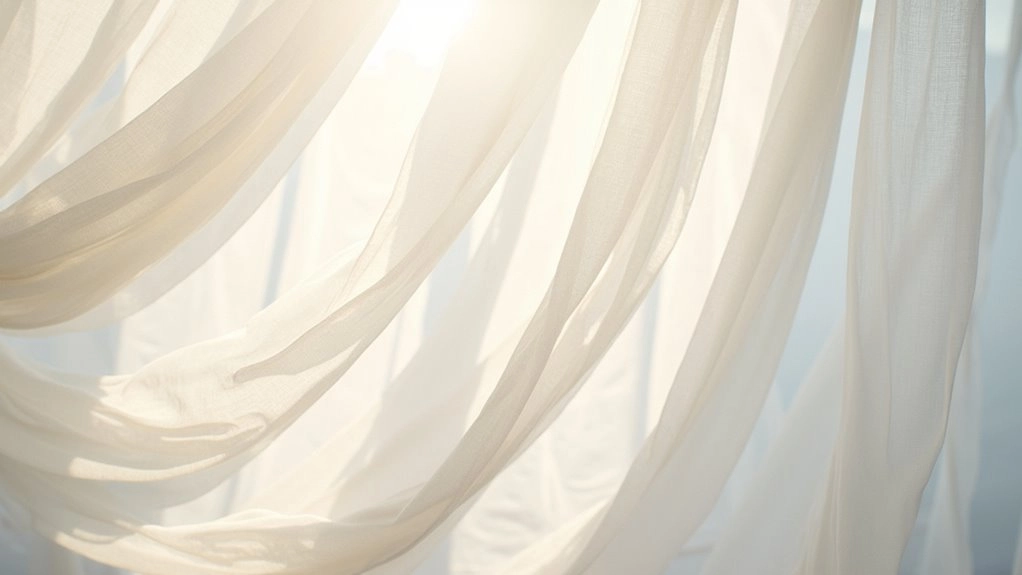
Modern manufacturing techniques have transformed traditional muslin production into a streamlined industrial process.
Today's muslin fabric is lightweight and made using specialized machines that carefully weave cotton threads into the characteristic plain weave pattern. Various types of cotton are used, affecting the final quality and sustainability of the fabric.
- Raw cotton is cleaned and carded to align fibers.
- Spinning machines convert cotton into uniform threads.
- Industrial looms weave threads in a plain weave pattern.
- Quality control guarantees consistent fabric weight.
- Final processing includes bleaching or dyeing as needed.
Care and Maintenance Guidelines for Muslin Fabric
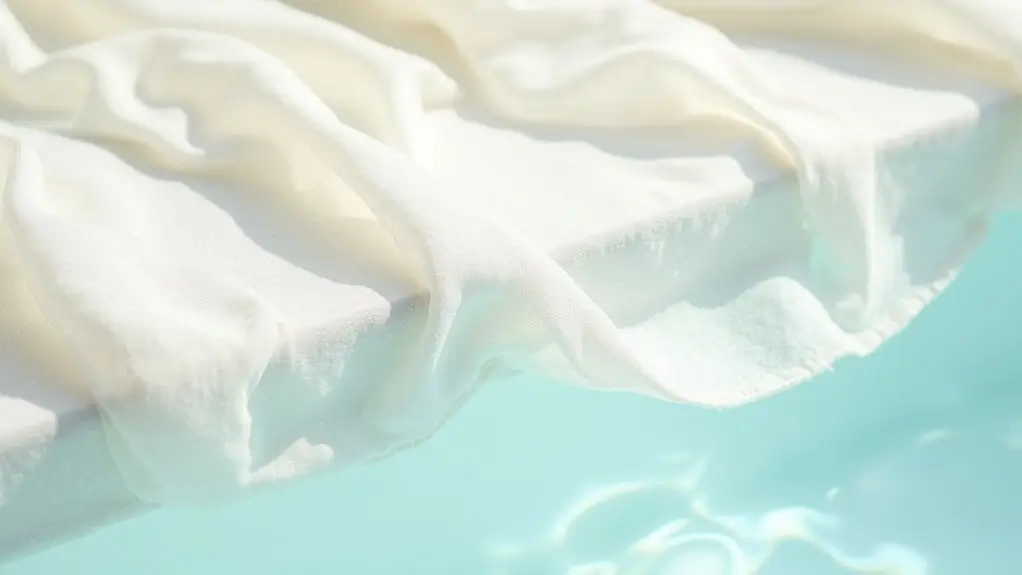
Caring for your muslin fabric properly ensures it lasts long and keeps its good qualities over the years.
When working with muslin by the yard, you should pre-wash it before any project.
For regular maintenance, you can machine wash your muslin in cool water with mild detergent. If you're dealing with delicate pieces or stubborn stains, hand wash the fabric and pre-treat any spots before laundering.
Always opt for air drying instead of using a dryer, as high heat can damage the fibers.
Store your clean muslin in a cool, dry place away from direct sunlight. This will prevent yellowing and deterioration.
Muslin's Global Impact on the Textile Industry
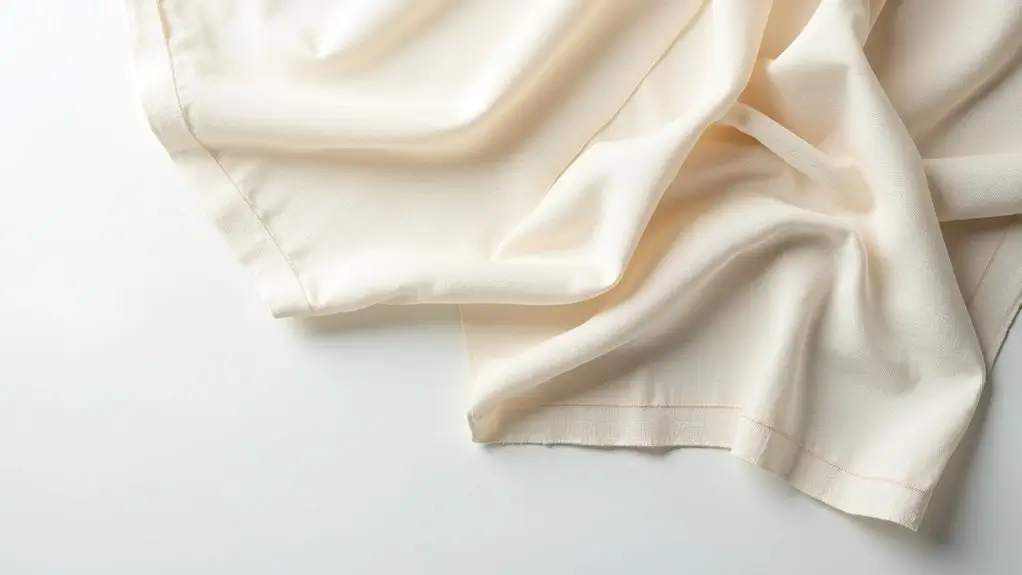
Beyond individual care practices, the production and trade of muslin considerably shape global textile markets.
When you buy muslin fabric today, you join a long tradition that grows with modern sustainability practices.
- India remains the world's largest producer of premium cotton muslin varieties.
- Sustainable muslin production has increased 40% globally since 2015.
- Bangladesh has emerged as a leading manufacturer of organic muslin.
- European markets primarily import high-grade muslin for the fashion industry.
- Local economies benefit from small-scale muslin production initiatives.
This type of cotton fabric is highly versatile. Its growing demand has made it important in international trade. Eco-conscious consumers are especially seeking sustainable textile options like this fabric.
Conclusion
You've now discovered why muslin remains a cornerstone in today's textile world. From its humble beginnings in ancient Mosul to its current status as a craft essential, this fabric continues to meet diverse needs across industries.
Whether sewing prototypes, wrapping your baby, or making home decor, muslin's strength and flexibility make it a valuable material. It's truly a fabric that will serve you well in countless projects.
Learn more fabric knowledge on the Longan Craft Blog, and dive into the fabric world with Longan Craft!
FAQs
Can Muslin Be Used as a Natural Filter for Homemade Beverages?
Muslin is a natural filter for homemade beverages. It's perfect for straining tea, coffee, juice, or homemade wine. Just verify that you're using clean, unbleached muslin for food safety.
How Long Does Natural, Undyed Muslin Take to Biodegrade Completely?
When buried in soil, it usually takes 2-5 months to biodegrade completely. Its pure cotton composition allows it to break down faster than synthetic fabrics.
Is Muslin Suitable for Outdoor Furniture Covers in Rainy Climates?
You shouldn't use untreated muslin for outdoor furniture covers in rainy climates. It'll absorb water and promote mildew growth. Even with waterproofing, it's not durable enough for long-term outdoor exposure.


0 comments